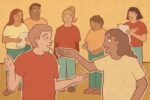We’ve all heard the parable of the “broke” college student. Ramen and cheap snacks galore. And sure, some college students will feel some sort of financial hardship during their time at school in which eating out for the week means the McDonald’s dollar menu and not Chipotle.
This is no doubt a difficult situation for those experiencing it, especially students who are living on their own for the first time, but while the “broke” college student, stereotypical meme it is, has become a common expectation and even a laughable one sometimes, poor college students are stilling flying under the radar in shame.
By “poor college student” I mean those who come from low-income or working-class families, or those whose families make less than $35,000 per year. And even the phrase “poor college students” is a bit of an umbrella term — bringing together both those who truly lived in poverty and struggled to make ends meet and those who make more, but still live from paycheck-to-paycheck.
For example, the Federal Poverty Line (FPL) for a family of four is $24,600, so those who come from a family below or near the FPL have lived in financial hardships for likely most of their lives. But to say that every low-income student has experienced these struggles in the same way is homogenizing.
I’m a low-income student. My family has been under the $35,000 mark for as long as I can remember. I consider myself to be very lucky in regard to my current college situation.
It’s thanks to a program from the state of Indiana called Twenty First Century Scholars, which provides free tuition to low-income students as long as they maintain a certain GPA and attend an Indiana college, and a supplement program from Purdue University itself, Purdue Promise. Between these two remarkable programs, I’m able to attend college and leave with minimal student loan.
As I mentioned, it’s homogeneous to believe all low-income students have the same experience, just as it is with any minority group. But there has been a noticeable decrease recently in the number of low-income students enrolling at college, and this does not include actually number of students getting in or graduating from one. From 2008 to 2013, the number of college students classified as low-income dropped from 55.9 percent to 45.5 percent.
Money is the biggest contributing factor to this. Tuition prices continue to rise and the amount of financial aid provided has a hard time keeping up. Those large price tags are enough to deter anyone whose family’s annual income is even less that the tuition.
Enrolling and getting into college is one thing, a very large thing, but even if a student is able to attend school, once they are actually in college, despite what they say about reinventing yourself, students’ low-income background continues to impact their life and their study more than it has ever been.
There are four overall aspects of college life that low-income and high-income students will experience much differently. This socioeconomic gap definitely has an impact on their interactions with each other as well. These four aspects are: social life, money, opportunities and academics.
1. Social Life
Now I’m a naturally awkward, self-conscious introvert, so granted that probably has a big part in my struggle to make friends. It does. But what I want to address is not so much having friends on an individual basis but the broader spectrum of daily social interaction.
While, yes, certain personality traits can affect how individuals interact and function within the community, the fact that they came from a low-income family affects a student’s “rank,” so to speak, on a social hierarchy on campus.
I notice quite often that the people around me know more, have more and act accordingly. What this means is high-income students are generally more prepared for college in terms of knowledge, substance or material items and social confidence.
Class indicators are everywhere: in the clothes people wear, the things they own, the way they talk and act. Everything about them is more confident. And I’m painfully reminded that I’m not one of them.
Icebreakers are my worst nightmare. I’m a college freshman. Those two sentences together are asking for disaster. Let’s just say when playing an icebreaker equivalent of “Never Have I Ever,” I thought that I could not possibly be the only one in my entire group to have never flown on a plane before. I was wrong, very wrong.
The awkward silence following my confession was a plain indicator on my second day on campus that I was not on a level playing field with most of the people here.
But don’t take it just from me. In an article titled, What Is It Like to Be Poor at an Ivy League School?, author Brook Lea Foster talks to three students, two from Harvard University and one from Brown University, about what it’s like to be poor in some of the most selective colleges in the country.
The first student, Ana Barros, describes how many of her classmates talked about buying expensive clothes or planning exotic spring break trips and her response is all too true: “They weren’t always conscious of how these conversations can make other people feel,” she says, “Admitting you’re poor to your peers is sometimes too painful. Who wants to be that one student in class speaking for everyone?”
2. Money
That dreaded thing. It runs the world and has much too powerful a grip on the life of those who are poor. Paying for college is an actually impossible task for low-income families without the help of aid, but even then, the aid only does so much and the rest must be covered by loans, which is another financially precarious situation for those already struggling.
And it doesn’t stop there. Once the loan agreements are signed, or if one is lucky enough to receive enough scholarships, there is still day to day living that has to be taken care of. Most will have to get on-campus jobs to help pay for things such as food, clothes, or toiletries.
Due to my scholarships and job at an on-campus dining court, food is now something I don’t have to worry about, which is another reason I consider myself lucky. I get a free meal with every shift at the dining court and a certain number of meal swipes per week, which means I’m eating well for the first time in my life, too well, in actuality. But, when I return home to see my parents’ frozen meals and peanut butter and jelly sandwiches, I feel guilty, remembering that just mere months ago that was me too.
Money also affects students as, while they struggle to balance going to class and going to work, they also want to hang out with their friends. Except when their friends want to go eat at some expensive restaurant and engage in other equally expensive activities, all the low-income student can see is dollar signs. So, instead of having a good time, they are concerned about where this entertainment money could have gone.
3. Opportunities
For most of my life, I struggled to understand why everyone else could do or have what they wanted when they wanted it.
I got my first job when I was 15 — only two other people I have met have also done this — and during my senior year in high school, I had two jobs, but all the while I would check Snapchat stories or my Instagram feed and see people go off on road trips, vacations, or just for a day out while I was stuck working a double for the third day in a row.
And now, at college, I sit and listen to stories of people’s amazing vacations or study-abroad experiences, and well, I haven’t gone on anything resembling a vacation since I was eleven.
It’s a simple equation: more money, more opportunities. High-income students have the monetary freedom to do things that will help them in the future, such as workshops, summer camps, extra classes, or traveling. And with these opportunities, well, their college applications are going to shine.
And this gets them into some of the most elite colleges such as Trinity, a private university, which gives them a high quality education and a name on their resume that employers want to see. Yet, for low-income students, their scores and applications aren’t as shiny, which can likely lead them to underfunded community colleges.
Especially for poor students that attend even poorer high schools, their access to shining college opportunities is slim to none. The three students from Ball High School in Galveston, Texas, who told their stories to “The New York Times”, can attest to that.
One of the students was at the top of her class and was considering transferring to a private school, but “protecting families from their own ambition is a skill many poor students learn” and she told the Times, “I knew we didn’t have the money. I felt I had no right to ask.”
4. Academics
A recent study shows that 77 percent of students from families of the top quartile, those that make $108, 650 or more, will receive a bachelor’s degree by age twenty-four, compared to only 9 percent of those in the bottom quartile, or families that make less than $34,160. These are rather staggering numbers.
This brings us back to the point that low-income students are less prepared to enter the rigor of college courses. There are multiple reasons for this. One is a lack of resources or exposure to quality education in their hometowns or schools.
Without access to books, after school programs, or academic help like tutoring, they learn at a slower rate and are generally behind once they get to college. 64 percent of low-income students attending a two-year college and thirty-two percent attending a four-year college needed remediation classes.
A lack of stability is another reason. Homes that are low-income tend to have recurring problems which makes it hard for students to stay focused on their schoolwork. This could be health issues, relationship issues, and, of course, financial issues.
This also ties into first generation students, who is the first in their family to attend college, because without the background or experience and support from parents, getting in and through college is much harder. First generation students are four times as likely to drop out of college their first year because of this.
All of this information seems rather dismal, doesn’t it? My intentions aren’t to desperately grapple at pity for low-income people or to “complain” about their hardships, but rather raise awareness. If a high-income student reads this article, take it as a call to action.
Go and reach out to other students that aren’t as privileged economically. Don’t let the social gap on campuses become wider. If a low-income student reads this, take it as some hope. The odds are stacked against you, in more ways than one, but don’t let that deter you. There are ways to get help, but please, don’t be afraid to ask for it. Everyone deserves a chance.

















